New findings on hair loss in men
Researchers in Bonn identify rare genetic variants involved in male-pattern hair loss
A receding hairline, a total loss of hair from the crown, and ultimately, the classical horseshoe-shaped pattern of baldness: Previous research into male pattern hair loss, also termed androgenetic alopecia, has implicated multiple common genetic variants. Human geneticists from the University Hospital of Bonn (UKB) and by the Transdisciplinary Research Unit “Life & Health” of the University of Bonn have now performed a systematic investigation of the extent to which rare genetic variants may also contribute to this disorder. For this purpose, they analyzed the genetic sequences of 72,469 male participants from the UK Biobank project. The analyses identified five significantly associated genes, and further corroborated genes implicated in previous research. The results have now been published in the prestigious scientific journal Nature Communications.
Male-pattern hair loss is the most common form of hair loss in men, and is largely attributable to hereditary factors. Current treatment options and risk prediction are suboptimal, thus necessitating research into the genetic underpinnings of the condition. To date, studies worldwide have focused primarily on common genetic variants, and have implicated more than 350 genetic loci, in particular the androgen receptor gene, which is located on the maternally inherited X chromosome. In contrast, the contribution to this common condition of rare genetic variants has traditionally been assumed to be low. However, systematic analyses of rare variants have been lacking.
“Such analyses are more challenging as they require large cohorts, and the genetic sequences must be captured base by base, e.g., through genome or exome sequencing of affected individuals,” explained first author Sabrina Henne, who is a doctoral student at the Institute of Human Genetics at the UKB and the University of Bonn. The statistical challenge lies in the fact that these rare genetic variants may be carried by very few, or even single, individuals. “That is why we apply gene-based analyses that first collapse variants on the basis of the genes in which they are located,” explained corresponding author PD Dr. Stefanie Heilmann-Heimbach, who is a research group leader at the Institute of Human Genetics at the UKB and at the University of Bonn. Among other methods, the Bonn researchers used a type of sequence kernel association test (SKAT), which is a popular method for detecting associations with rare variants, as well as GenRisk, which is a method developed at the Institute of Genomic Statistics and Bioinformatics (IGSB) at the UKB and the University of Bonn. […]
Participating Core Facilities: The authors acknowledge the support from the Bioinformatics Core Facility.
Participating institutions and funding: The research was supported by funding from the Medical Faculty of the University of Bonn. Prof. Dr. Markus Nöthen, Director of the Institute of Human Genetics at UKB and co-author of the study, is a member of the Transdisciplinary Research Area (TRA) “Life and Health” at the University of Bonn. The publication costs in open access format were funded by the DEAL project of the University of Bonn.
Publication: S. K. Henne et al.: Analysis of 72,469 UK Biobank exomes links rare variants to male-pattern hair loss; Nature Communications; DOI: https://doi.org/10.1038/s41467-023-41186-w







